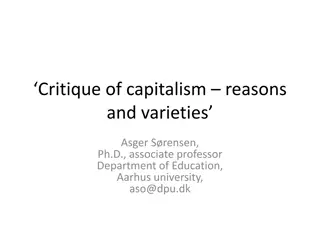Queer Art Beyond Identity Politics: Exploring Capitalism, Gentrification, and LGBT+ Inequalities
Explore the complex intersections of capitalism, gentrification, and LGBT+ identities through the lens of queer art and community activism. Unpack the nuances of human capital theory, dominance of middle-class white gay men, and challenges faced by people of color within the LGBT+ community. Contemplate the role of participatory queer art in addressing these issues and promoting inclusivity. Delve into thought-provoking discussions on creating monuments dedicated to the queer community and redefining public art spaces for social change.
Download Presentation

Please find below an Image/Link to download the presentation.
The content on the website is provided AS IS for your information and personal use only. It may not be sold, licensed, or shared on other websites without obtaining consent from the author. Download presentation by click this link. If you encounter any issues during the download, it is possible that the publisher has removed the file from their server.
E N D
Presentation Transcript
About myself Tilen Kolar University of Leeds 2nd Year BA Economics and Geography Laidlaw Scholar Slovenia gy18tk@leeds.ac.uk +38631822440 Instagram: tilen_
Activity 1 Imagine you are a group of artists. Leeds City Council has commissioned you to design and situate a monument dedicated to the queer community. Using modelling clay and maps, try to design and situ such a monument.
Capitalism and LGBT+ Identity Politics Human Capital Theory Promise of the authentic self at the point of consumption Inequalities within the LGBT+ community Dominance of middle-class white gay men Gentrification of LGBT+ spaces is it unqueer?
Human capital theory, promise of the authentic self at the point of consumption basis for the inequalities within the LGBT community Pellegrini (2002)
Gentrification of LGBT+ spaces and the dominance of white middle-class gay men (Mitchell, 2000)
In the US, in 2012, more than 70% of victims of violence against sexual and gender minorities were people of colour. (Giovanniello, 2013) Johnston (2017) observed that especially black queer and black trans find it uncomfortable to participate in Pride Parades
Participatory Queer Art as a Solution? Public art spaces of agony (Mouffe, 2007) Positive effects on the LGBT+ community observed by Orangias et al (2018) Vital materiality? (Bennett, 2010)
Homomonument Homomonument Queer A Case study of the Homomonument, a part of the research project Queer Memorials: Internaational Comparative Perspectives on Sexual Diversity and Social Inclusivity (Qmem) Queer Space Space? ? Space is the arena for power relations. In the case of the Homomonument, the latter can be questioned by ordinary people by creatively and critically thinking about them. 1. INTRODUCTION The Homomonument is a memorial dedicated to lesbians and gays that were persecuted because of their sexuality. The pink triangle was a symbol used during nazism to mark homosexuals. Our case study research about every day engagement with the Homomonument is part of the Qmem project, examining the role of the LGBT+ dedicated monuments in terms of queering space. How would you describe this place in 3 keywords? Some of the survey questions: "Homomonument is for everyone?", "Should the name Homomonument be changed?" or "How would you change the Homomonument?" were asked in order to examine critical thinking of people at the monument. 2. AIMS AND OBJECTIVES What queer memorials mean and which emotions do they evoke to people within and beyond LGBT communities. Major challenge: Analysing demographics of participants, because as queer scholars we believe in fluid identities that cannot be categorized for the quntitative analysis. We want to discover if the abstract construction of the Homomonument is something fluid for people, so that they dare to engage with it, or is it mainly a statical historical marker placed in Amsterdam. 4. NEXT STEPS So far, the data and qualitative responses are still in the process of being analysed. We are focusing on finding potential relationships between particular ways of responding to questions that test critical thinking, and demographic characteristics in order to reveal potential exclusionary and inclusionary processes. 3. METHODOLOGY As queer geographers, we were interested in the combination of qualitative and quantitative data. We collected 344 survey responses and conducted several follow-up interviews Tilen Kolar, School of Geography, University in Leeds, e-mail: gy18tk@leeds.ac.uk; in collaboration with research supervisor Dr. Martin Zebracki, School of Geography, University of Leeds https://queermemorials.leeds.ac.uk
Reference list Pellegrini, A. 2002. Consuming Lifestyle: Commodity Capitalism and Transformations in Gay Identity. In: Cruz-Malave, A., Manalansan, M. eds. Queer Globalizations: Citizenship and the Afterlife of Colonialism. New York: New York University Press, pp.134-149. Mitchell, D. 2000. Sex and Sexuality: The cultural politics and political geography of liberation. In: Mitchell, D, Cultural Geography: A Critical Introduction. pp.171-198. Oxford: Blackwell Bennett, J. 2010. Vibrant Matter: a political ecology of things. Durham: Duke University Press.























